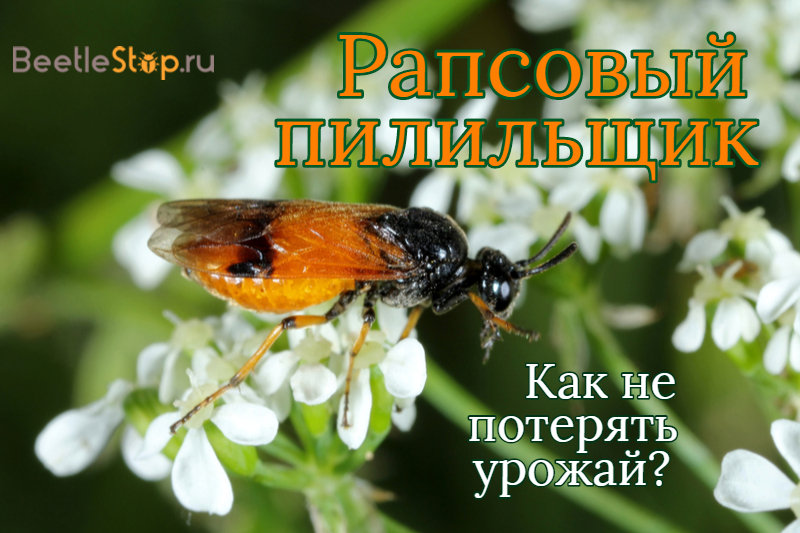Rapeseed sawfly - pseudo-caterpillars in the fields
The family of real sawflies includes 5.5 thousand species. Some of them are harmful to fruit, berry and agricultural crops, forest plantations. The name of the group was given to insects for the structure of the female’s ovipositor, which resembles a saw blade in a notch. Rapeseed sawfly is a common pest of cabbage crops. Its larvae spoil winter and spring rape, cabbage, turnips, mustard. Compliance with agricultural guidelines helps prevent crop losses.

View description
Rapeseed sawfly (Athaliarosae) hymenoptera insects, common. The abdomen of the adult is firmly attached to the chest without the waist characteristic of other hymenoptera. Body length 6-8 mm. Coloring yellow-orange, glossy integument. There are two black spots on the back. Two pairs of transparent wings are attached to the chest. At the base they are yellow, and on the outer edge is a black border.
The head is black. The mouth apparatus is gnawing. The club-shaped, 11-segmented antennae are well developed. They are the organs of touch. The chest consists of three segments, 3 pairs of running legs are attached to it. The limbs are yellowish with black rings. Sexual dimorphism is manifested in the structure of the abdomen. In the male, the abdomen is short and rounded; in the female, the abdomen is wide at the base and pointed at the end.
Habitat
Rapeseed sawflies are widespread in Europe, in Asia, in northern Africa. In Russia, it harms crops in the European part of the country and the North Caucasus. It is found in all regions to the Far East. Insects prefer the forest-steppe and steppe zones.
Lifestyle & Reproduction
The adult years begin in April-May. They feed on nectar on umbrella and cruciferous crops. Insects hold in groups, fly from place to place. The damage to crops is caused not by adults, but by their voracious offspring. Larvae eat soft young leaves, buds, pods. Two generations are developing over the year. Second-generation imagoes fly in July-August. In the hottest areas of the Crimea appears and the third generation.
Information. In rainy spring unfavorable conditions for rapeseed sawflies are formed. Adults do not fly in wet weather and do not eat. They hide from moisture on the underside of leaves. Most insects die.
Breeding
After additional nutrition on honey plants, imagoes mate. The female lays eggs on the underside of rapeseed and turnip leaves, as well as wild cruciferous ones - the forest bark, caraway, hemlock, field yarok. She makes punctures in the tissues of plants with an acute ovipositor and lays one egg at a time. Masonry is carried out on different leaves, often the female flies from plant to plant. Having fulfilled the function of procreation, the female dies. The eggs are oval, light yellow. The masonry is stretched for 3-4 weeks. Total fecundity is 250-300 pieces. Embryonic development takes 5-12 days.
Information. Separate larvae of the first generation in the absence of feed fall into diapause until the next year.
Rapeseed sawfly refers to an insect with a complete transformation. Larvae of this species look like caterpillars. But from the offspring of butterflies, the caterpillars differ in the presence of 6 or more pairs of limbs on the abdomen and two simple eyes on the head.The offspring of sawflies is born 2.5 mm long, the color is light. Adult larvae are greenish-black; longitudinal brown stripes on the back and sides. The body is wrinkled.
In the process of development, 4-5 links pass. The older caterpillar reaches a length of 25 mm. They have a black head, 3 pairs of chest and 8 pairs of abdominal legs. Pests are active in the morning when the weather is clear. Cooling and rain are waiting on the underside of the leaves or burrowing into the ground.
Larvae of 6 age are called eonymphs. They stop feeding and sink into the soil for pupation. False caterpillars burrow into the ground to a depth of 2-3 cm. They build a strong cocoon. The cradle for the pupa is brown outside and silver inside. The pupal stage takes 8-15 days. Pupa is light yellow; its length is 7-8 mm. Adults appear in July-August. Females lay eggs on cruciferous weeds and canola. Second generation false caterpillars do the most harm. They stay for the winter. Insects crawl deep into the soil by 10-12 cm, where they build a cocoon. Pupation occurs in spring when the earth warms up to 16 °.
Favorable living conditions - temperature 23-25 °, humidity 70-80%. Summer heat causes the larvae to hide in the ground and stop development. The natural enemies of the sawflies are wasp riders. They lay their eggs on the larvae. Parasites grow in the body of false caterpillars, at the end of development they kill the host.
Malware
The larvae diet includes radish, rutabaga, mustard, rapeseed, rutabaga. False caterpillars eat the leaves, leaving only the veins intact. Larvae develop 15-20 days. During this time, they manage to cause great harm to the crops of cabbage crops. In addition to foliage, flowers and ovary are eaten. Even with slight damage, the sheet is covered with a grid of holes. Plants weaken, dry and die. With the mass distribution of sawflies, 80-90% of the rape crop dies.
Methods of struggle
Agrotechnical measures
- Destruction of weeds in the fields and around the perimeter of the site.
- Compliance with crop rotation. Re-growing rapeseed in the same area increases the likelihood of infection.
- Deep plowing in autumn or early spring, contributing to the destruction of cocoons with pupae.
- Landing of bait sites with cruciferous plants. The bait is mowed and burned along with pests that have moved onto it.
- Destruction of crop residues after harvesting.
Chemical treatment
When colonizing winter rapeseed crops, 2 larvae per plant need to be sprayed with one of the contact-intestinal insecticides: Kinfos, Fastak, Karate Zeon, Fufanon.


In the lifestyle section, it’s important in the information -Hide (written break)
Thanks! Bug fixed)